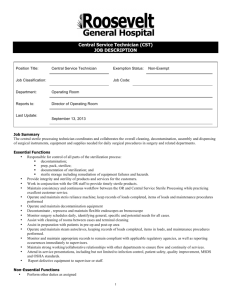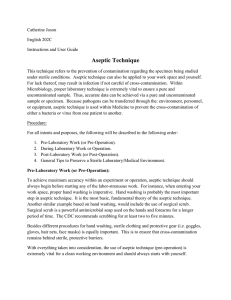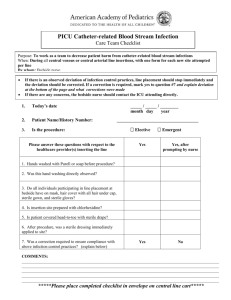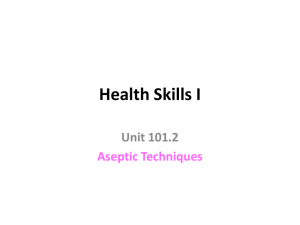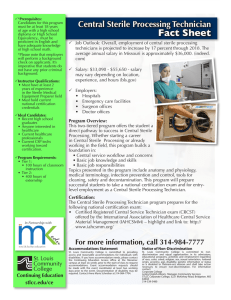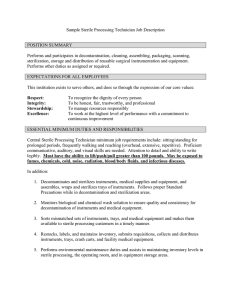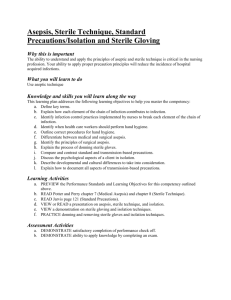Cleanroom For Sterile Manufacturing Facilities Praphon Angtrakool
advertisement
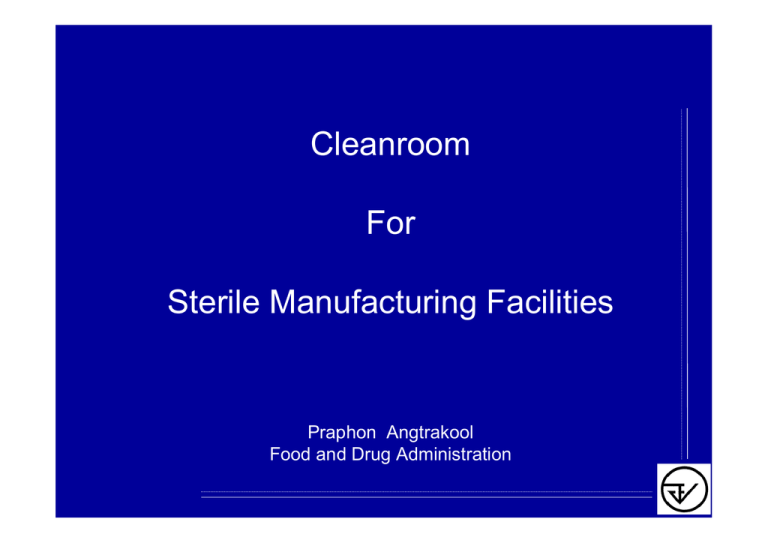
Cleanroom For Sterile Manufacturing Facilities Praphon Angtrakool Food and Drug Administration WHO TRS No. 823 Annex 1, 1992 (1) General 17.1 The production of sterile preparations should be carried out in clean areas, entry to which should be through airlocks for personnel and/or for goods. Clean areas should be maintained to an appropriate standard of cleanliness and supplied with air that has passed through filters of an appropriate efficiency. 17.2 The various operations of component preparation (such as containers and closures), product preparation, filling and sterilization should be carried out in separate areas within a clean area. 17.3 Clean areas for the production of sterile products are classified according to the required characteristics of the air, in grades A, B, C and D (see Table 1) 1 WHO TRS No. 823 Annex 1, 1992 (2) Table 1. Air classification system for manufacture of sterile products Maximum number of particle permitted per m3 0.5 – 5 µm > 5 µm Maximum number of viable micro-organism per m3 A (Laminar airflow workstation) 3 500 None Less than 1 B 3 500 None 5 C 350 000 2 000 100 D 3 500 000 20 000 500 Grade 2 WHO TRS No. 823 Annex 1, 1992 (3) General To obtain air of the required characteristics, methods specified by the national authorities should be used. It should be noted that : ¡ Laminar airflow systems should provide a homogeneous air speed of about 0.30 m/s for vertical flow and about 0.45 m/s for horizontal flow but precise air speeds will depend on the type of equipment. ¡ In order to reach the B, C and D air grades, the number of air changes should generally be higher than 20 per hour in a room with a good airflow pattern and appropriate HEPA (high-efficiency particulate air) filters. 3 WHO TRS No. 823 Annex 1, 1992 (4) General Low values for contaminants are reliable only when a large number of air samples are taken. ¡ The guidance given for the maximum permitted number of particles corresponds approximately to the United States Federal Standard 209 E (1992) as follows : Class 100 (grades A and B), Class 10 000 (grade C), and Class 100 000 (grade D) It may not always be possible to demonstrate conformity with particular air standards at the point of fill when filling is in progress, owing to the generation of particles or droplets from the product itself. 4 WHO TRS No. 823 Annex 1, 1992 (5) Manufacture of sterile preparations 17.5 Manufacturing operations are here divided into three categories : first, those in which the preparation is seal in its final container and terminally sterilized; second, those in which the preparation is sterilized by filtration; and third, those in which the preparation can be sterilized neither by filtration nor terminally and consequently must be produced from sterile starting materials in an aseptic way. Area grades as specified in section 17.5.1 – 17.5.3, must be selected by the manufacturer on the basis of validation runs (e.g., sterile media fills) 5 WHO TRS No. 823 Annex 1, 1992 (6) Terminally sterilized products 17.5.1 Solutions should generally be prepared in a grade C environment in order to give low microbial and particulate counts, suitable for immediate filtration and sterilization. Solution preparation could be allowed in a grade D environment if additional measures were taken to minimize contamination, such as the use of closed vessels. For parenterals, filling should be done in a laminar airflow workstation (grade A) in a grade C environment. The preparation of other sterile products, e.g., ointments, creams, suspensions and emulsions, and filling of containers should generally be done in a grade C environment before terminal sterilization. 6 WHO TRS No. 823 Annex 1, 1992 (7) Other sterile filtered products prepared from sterile materials in an aseptic way 17.5.2 The handling of starting materials and all further processing should be done in a grade A or B area with a grade B or C background respectively. 7 WHO TRS No. 823 Annex 1, 1992 (8) Typical Air Quality Classification (WHO TRS 823, 1992) Typical Process Step Terminally Sterilized Sterile Filtered Aseptically Processed Handling of sterile starting materials Grade C or use closed vessels in Grade D Background Grade C or use closed vessels in Grade D Background Grade A or B (Background Grade B or C respectively) Preparation of solutions Grade C or use closed vessels in Grade D Background Grade C or use closed vessels in Grade D Background Grade A or B (Background Grade B or C respectively) Filling Grade A Background Grade C (Parenteral) Grade A or B (Background Grade B or C respectively) Grade A or B (Background Grade B or C respectively) Grade C Grade A or B (Background Grade B or C respectively) Preparation and filling of ointments, emulsions, creams and suspensions Grade C 8 PIC/S,1 July 2004 (1) GENERAL 1. The manufacture of sterile products should be carried out in clean areas, entry to which should be through airlocks for personnel and/or for equipment and materials. Clean areas should be maintained to an appropriate cleanliness standard and supplied with air which has passed through filters of an appropriate efficiency. 2. The various operations of component preparation, product preparation and filling should be carried out in separate areas within the clean area. Manufacturing operations are divided into two categories; firstly those where the product is terminally sterilised, and secondly those which are conducted aseptically at some or all stages. 9 WHO, TRS 902 Annex 6, 2002 (1) 1. General considerations 1.1 The production of sterile preparations should be carried out in clean areas, entry to which should be through airlocks for personnel and/or for equipment and materials. Clean areas should be maintained to an appropriate standard of cleanliness and supplied with air that has passed through filters of the required efficiency. 1.2 The various operations of component preparation (such as those involving containers and closures), product preparation, filling and sterilization should be carried out in separate areas within a clean area. These areas are classified into four grades (see section 4.1). 1.3 Manufacturing operations are divided here into two categories : first, those where the product is terminally sterilized, and second, those which are conducted aseptically at some or all stages. 10 PIC/S,1 July 2004 (2) GENERAL 3 Clean areas for the manufacture of sterile products are classified according to the required characteristics of the environment. Each manufacturing operation requires an appropriate environmental cleanliness level in the operational state in order to minimize the risks of particulate or microbial contamination of the product or materials being handled. In order to meet “in operation” conditions these areas should be designed to reach certain specified air-cleanliness levels in the “at rest” occupancy state. The “at rest” state is the condition where the installation is installed and operating, complete with production equipment but with no operating personnel present. The “in operation” state is the condition where the installation is functioning in the defined operating mode with the specified number of personnel working. 11 WHO, TRS 902 Annex 6, 2002 (2) 4. Manufacture of sterile preparations 4.1 Clean areas for the manufacture of sterile products are classified according to the required characteristics of the environment. Each manufacturing operation requires an appropriate environmental cleanliness level in the operational state in order to minimize the risks of particulate or microbiological contamination of the product or materials being handled. In order to meet “in operation” conditions, these areas should be designed to reach certain specified air cleanliness levels in the “at rest” occupancy state. This latter state is the condition where the installation is complete, and production equipment has been installed and is operating, but no operating personnel are present. The “in operation” state is the condition where the installation is functioning in the defined operating mode and the specified number of personnel are present. 12 PIC/S,1 July 2004 (3) GENERAL For the manufacture of sterile medicinal products 4 grades can be distinguished. Grade A: The local zone for high risk operations, e.g. filling zone, stopper bowls, open ampoules and vials, making aseptic connections. Normally such conditions are provided by a laminar air flow work station. Laminar air flow systems should provide a homogeneous air speed in a range of 0.36 – 0.54 m/s (guidance value) at the working position in open clean room applications. The maintenance of laminarity should be demonstrated and validated. A uni-directional air flow and lower velocities may be used in closed isolators and glove boxes. Grade B: For aseptic preparation and filling, this is the background environment for grade A zone. Grade C and D: Clean areas for carrying out less critical stages in the manufacture of sterile products. 13 WHO, TRS 902 Annex 6, 2002 (3) 4. Manufacture of sterile preparations For the manufacture of sterile pharmaceutical preparations, four grades are distinguished here, as follows: ¡ Grade A : The local zone for high-risk operations, e.g. filling and making aseptic connections. Normally such conditions are provided by a laminar airflow workstation. Laminar airflow systems should provide a homogeneous air speed of approximately 0.45 m/s. ± 20% (guidance value) at the working position. ¡ Grade B : In aseptic preparation and filling, the background environment for the grade A zone. ¡ Grades C and D : Clean areas for carrying out less critical stages in the manufacture of sterile products. The airborne particulate classification for the four grades is given in Table 2. 14 PIC/S,1 July 2004 (4) The airborne particulate classification for these grades is given in the following table. At rest (b) Grade In operation (b) Maximum permitted number of particles/m 3 Equal to or above (a) 0.5 µm (d) 0.5 µm (d) 5 µm 5 µm A 3500 1 (e) 3500 1 (d) B (c) 3500 1 (e) 350 000 2000 C (c) 350 000 2000 3 500 000 20 000 D (c) 3 500 000 20 000 Not defined (f) Not defined (d) 15 WHO, TRS 902 Annex 6, 2002 (4) Table 2 : Airborne particulate classification for manufacture of sterile pharmaceutical preparations Grade At rest In operation Maximum number of particles permitted/m 3 Maximum number of particles permitted/m 3 0.5 – 5.0 µm 0.5 – 5.0 µm > 5.0 µm > 5.0 µm A 3500 0 3500 0 B 3500 0 350 000 2000 C 350 000 2000 3 500 000 20 000 D 3 500 000 20 000 Not defined Not defined 16 PIC/S,1 July 2004 (5) Notes : (a) Particle measurement based on the use of a discrete airborne particle counter to measure the concentration of particles at designated sizes equal to or greater than the threshold stated. A continuous measurement system should be used for monitoring the concentration of particles in the grade A zone, and is recommended for the surrounding grade B areas. For routine testing the total sample volume should not be less than 1 m³ for grade A and B areas and preferably also in grade C areas. (b) The particulate conditions given in the table for the “at rest” state should be achieved after a short “clean up” period of 15-20 minutes (guidance value) in an unmanned state after completion of operations. The particulate conditions for grade A “in operation” given in the table should be maintained in the zone immediately surrounding the product whenever the product or open container is exposed to the environment. It is accepted that it may not always be possible to demonstrate conformity with particulate standards at the point of fill when filling is in progress, due to the generation of particles or droplets from the product itself. 17 WHO, TRS 902 Annex 6, 2002 (5) 4. Manufacture of sterile preparations 4.2 The particulate conditions given in Table 2 for the “at rest” state should be achieved in the absence of the operating personnel after a short “clean-up” period of about 15 – 20 minutes (guidance value), after completion of the operations. The particulate conditions given in Table 2 for grade A “in operation” should be maintained in the zone immediately surrounding the product whenever the product or open container is exposed to the environment. It is accepted that it may not always be possible to demonstrate conformity with particulate standards at the point of fill when filling is in progress, owing to the generation of particles or droplets from the product itself. 18 PIC/S,1 July 2004 (6) (c) In order to reach the B, C and D air grades, the number of air changes should be related to the size of the room and the equipment and personnel present in the room. The air system should be provided with appropriate terminal filters such as HEPA for grades A, B and C. (d) The guidance given for the maximum permitted number of particles in the “at rest” and “in operation” conditions correspond approximately to the cleanliness classes in the EN/ISO 14644-1 at a particle size of 0.5 mm. (e) These areas are expected to be completely free from particles of size greater than 5 µm. As it is impossible to demonstrate the absence of particles with any statistical significance, the limits are set to 1 particle/m3 During the clean room qualification it should be shown that the areas can be maintained within the defined limits. (f) The requirements and limits will depend on the nature of the operations carried out. 19 WHO, TRS 902 Annex 6, 2002 (6) 4. Manufacture of sterile preparations To obtain air of the required characteristics, methods specified by national authorities should be used. It should be noted that: ¡ In order to reach the B, C and D air grades, the number of air changes should be appropriate for the size of the room and the equipment and personnel present in it. At least 20 air changes per hour are usually required for a room with a good airflow pattern and appropriate high-efficiency particulate air (HEPA) filters. ¡ Detailed information on methods for determining the microbiological and particulate cleanliness of air, surfaces, etc. is not given here. Reference should be made to other guidelines published in compendia such as the European, Japanese or United States pharmacopoeias, or in documents issued by the European Committee for Standardization and the International Organization for Standardization (ISO). 4.3 In order to control the particulate cleanliness of the various clean areas during operation, they should be monitored. 20 PIC/S,1 July 2004 (7) GENERAL 4. The areas should be monitored during operation in order to control the particulate cleanliness of the various grades. 5. Where aseptic operations are performed monitoring should be frequent using methods such as settle plates, volumetric air and surface sampling (e.g. swabs and contact plates). Sampling methods used in operation should not interfere with zone protection. Results from monitoring should be considered when reviewing batch documentation for finished product release. Surfaces and personnel should be monitored after critical operations. 21 WHO, TRS 902 Annex 6, 2002 (7) 3. Sanitation 3.3 In order to control the microbiological cleanliness of the various grades in operation, the clean areas should be monitored. Where aseptic operations are performed, monitoring should be frequent and methods such as settle plates, and volumetric air and surface sampling (e.g. swabs and contact plates) should be used. The zones should not be contaminated through the sampling methods used in the operations. The results of monitoring should be considered when batch documentation for release of the finished product is reviewed. Both surfaces and personnel should be monitored after critical operations. 22 PIC/S,1 July 2004 (8) Recommended limits for microbiological monitoring of clean areas during operation : Recommended limits for microbial contamination(a) Grade Air sample cfu/m3 Settle plates (diam. 90 mm) cfu/4 hours (b) Contact plates (diam. 55 mm) cfu/plate Glove print 5 fingers cfu/glove A <1 <1 <1 <1 B 10 5 5 5 C 100 50 25 - D 200 100 50 - Notes : (a) These are average values. (b) Individual settle plates may be exposed for less than 4 hours. 23 WHO, TRS 902 Annex 6, 2002 (8) Table 1. Limits for microbiological contaminationa Grade b Air sample (CFU/m3) Settle plates (diameter 90 mm) (CFU/4 hours)c Contact plates (diameter 55 mm) (CFU/plate) Glove print (5 fingers) (CFU/glove) A <3 <3 <3 <3 B 10 5 5 5 C 100 50 25 -- D 200 100 50 -- a These are average values. The grades are defined in section 4.1. b The airborne particulate classification for the four grades is given in Table 2. c Individual settle plates may be exposed for less than 4 hours. 24 The ISO Guide values for microbiological monitoring in the operational state Recommended limits for microbial contamination ISO 14644-1 Class Air sample cfu/m3 Settle plates ( φ 90 mm) cfu/4 hours Contact plates ( φ 55 mm) cfu/plate Glove print 5 fingers cfu/glove Class 5 (LF) <1 <1 <1 <1 Class 5 (Tur.) 10 5 5 5 Class 6 50 25 10 - Class 7 100 50 25 - Class 8 200 100 50 - Class 9 Not defined Not defined Not defined Not defined LF = uni-directional flow or laminar air flow ; Tur. = turbulent or non uni-directional flow 25 The EU GMP Guide (1997) values for microbiological monitoring in the operational state, for the manufacture of sterile products. Recommended limits for microbial contamination(a) Grade (a) (b) Air sample cfu/m3 Settle plates ( φ 90 mm) cfu/4 hours(b) Contact plates ( φ 55 mm) cfu/plate Glove print 5 fingers cfu/glove A <1 <1 <1 <1 B 10 5 5 5 C 100 50 25 - D 200 100 50 - There are average values Individual settle plates may be exposed for less than 4 hours 26 PIC/S,1 July 2004 (9) TERMINALLY STERILISED PRODUCTS 11. Preparation of components and most products should be done in at least a grade D environment in order to give low risk of microbial and particulate contamination, suitable for filtration and sterilisation. Where there is unusual risk to the product because of microbial contamination, for example, because the product actively supports microbial growth or must be held for a long period before sterilisation or is necessarily processed not mainly in closed vessels, preparation should be done in a grade C environment. 27 WHO, TRS 902 Annex 6, 2002 (9) Terminally sterilized products 4.6 Components and most products should be prepared in at least a grade D environment in order to give low microbial and particulate counts, suitable for filtration and sterilization. Where the product is at unusual risk of microbial contamination (e.g. because it actively supports microbial growth, must be held for a long period before sterilization, or is necessarily not processed mainly in closed vessels), the preparation should generally be done in a grade C environment. 28 PIC/S,1 July 2004 (10) TERMINALLY STERILISED PRODUCTS Filling of products for terminal sterilisation should be done in at least a grade C environment. Where the product is at unusual risk of contamination from the environment, for example because the filling operation is slow or the containers are wide-necked or are necessarily exposed for more than a few seconds before sealing, the filling should be done in a grade A zone with at least a grade C background. Preparation and filling of ointments, creams, suspensions and emulsions should generally be done in a grade C environment before terminal sterilisation. 29 WHO, TRS 902 Annex 6, 2002 (10) Terminally sterilized products 4.7 The filling of products for terminal sterilization should generally be done in at least a grade C environment. 4.8 Where the product is at unusual risk of contamination from the environment (e.g. because the filling operation is slow or the containers are wide-necked or are necessarily exposed for more than a few seconds before sealing), the filling should be done in a grade A zone with at least a grade C background. 4.9 The preparation and filling of ointments, creams, suspensions and emulsions should generally be done in a grade C environment before terminal sterilization. 30 PIC/S,1 July 2004 (11) ASEPTIC PREPARATION 12 Components after washing should be handled in at least a grade D environment. Handling of sterile starting materials and components, unless subjected to sterilisation or filtration through a micro-organism-retaining filter later in the process, should be done in a grade A environment with grade B background. Preparation of solutions which are to be sterile filtered during the process should be done in a grade C environment; if not filtered, the preparation of materials and products should be done in a grade A environment with a grade B background. 31 WHO, TRS 902 Annex 6, 2002 (11) Aseptic preparation 4.10 Components after washing should be handled in at least a grade D environment. The handling of sterile starting materials and components, unless subjected to sterilization or filtration through a micro-organism retaining filter later in the process, should be done in a grade A environment with a grade B background. 4.11 The preparation of solutions which are to be sterile filtered during the process should be done in a grade C environment; if not sterile filtered, the preparation of materials and products should be done in a grade A environment with a grade B background. 32 PIC/S,1 July 2004 (12) ASEPTIC PREPARATION Handling and filling of aseptically prepared products should be done in a grade A environment with a grade B background. Transfer of partially closed containers, as used in freeze drying, should, prior to the completion of stoppering, be done either in a grade A environment with grade B background or in sealed transfer trays in a grade B environment. Preparation and filling of sterile ointments, creams, suspensions and emulsions should be done in a grade A environment, with a grade B background, when the product is exposed and is not subsequently filtered. 33 WHO, TRS 902 Annex 6, 2002 (12) Aseptic preparation 4.12 The handling and filling of aseptically prepared products, as well as the handling of exposed sterile equipment, should be done in a grade A environment with a grade B background. 4.13 The transfer of partially closed containers, as used in freeze drying, should, before stoppering is completed, be done either in a grade A environment with a grade B background or in sealed transfer trays in a grade B environment. 4.14 The preparation and filling of sterile ointments, creams, suspensions and emulsions should be done in a grade A environment with a grade B background when the product is exposed and is subsequently filtered. 34 PIC/S,1 July 2004 (13) STERILISATION 55. All sterilisation processes should be validated. Particular attention should be given when the adopted sterilisation method is not described in the current edition of the European Pharmacopoeia, or when it is used for a product which is not a simple aqueous or oily solution. Where possible, heat sterilisation is the method of choice. In any case, the sterilisation process must be in accordance with the marketing and manufacturing authorizations. 56. Before any sterilisation process is adopted its suitability for the product and its efficacy in achieving the desired sterilising conditions in all parts of each type of load to be processed should be demonstrated by physical measurements and by biological indicators where appropriate. The validity of the process should be verified at scheduled intervals, at least annually, and whenever significant modifications have been made to the equipment. Records should be kept of the results. 35 PIC/S,1 July 2004 (14) STERILISATION BY RADIATION 70. Radiation sterilisation is used mainly for the sterilisation of heat sensitive materials and products. Many medicinal products and some packaging materials are radiation-sensitive, so this method is permissible only when the absence of deleterious effects on the product has been confirmed experimentally. Ultraviolet irradiation is not normally an acceptable method of sterilisation. STERILISATION WITH ETHYLENE OXIDE 76. This method should only be used when no other method is practicable. During process validation it should be shown that there is no damaging effect on the product and that the conditions and time allowed for degassing are such as to reduce any residual gas and reaction products to defined acceptable limits for the type of product or material. 36 PIC/S,1 July 2004 (15) FILTRATION OF MEDICINAL PRODUCTS WHICH CANNOT BE STERILISED IN THEIR FINAL CONTAINER 82. Filtration alone is not considered sufficient when sterilisation in the final container is possible. With regard to methods currently available, steam sterilisation is to be preferred. If the product cannot be sterilised in the final container, solutions or liquids can be filtered through a sterile filter of nominal pore size of 0.22 micron (or less), or with at least equivalent micro-organism retaining properties, into a previously sterilised container. Such filters can remove most bacteria and moulds, but not all viruses or mycoplasma’s. Consideration should be given to complementing the filtration process with some degree of heat treatment. 37 WHO, TRS 902 Annex 6, 2002 (13) 5. Sterilization 5.1 Whenever possible, products intended to be sterile should preferably be terminally sterilized by heat in their final container. Where it is not possible to carry out terminal sterilization by heating due to the instability of a formulation, a decision should be taken to use an alternative method of terminal sterilization following filtration and/or aseptic processing. 5.2 Sterilization can be achieved by the use of moist or dry heat, by irradiation with ionizing radiation (but not with ultraviolet radiation unless the process is thoroughly validated), by ethylene oxide (or other suitable gaseous sterilizing agents) or by filtration with subsequent aseptic filling of sterile final containers. Each method has its particular advantages and disadvantages. Where possible and practicable, heat sterilization is the method of choice. 38 Typical Air Quality Classification (PIC/S,2004) Terminally Sterilized Typical Process Step Aseptically Processed Products ”not unusually at risk” Products “unusually at risk” - - Grade D if sterile filtered Grade A with Grade B background if not sterile filtered Grade D Grade C(a) Grade C if sterile filtered Grade A with Grade B background if not sterile filtered Handling of components after washing Grade D Grade D + local protection Filling Grade C Grade A (b) (Background Grade C) Grade A (Background Grade B) Grade C Grade A (Background Grade B) Handling of sterile starting materials Preparation of solutions Preparation and filling of ointments, creams, suspensions and emulsions Transfer of partially closed containers, as used in freeze drying, should, before stoppering is completed Grade C - - Grade D Grade A Background Grade B or in sealed transfer trays in grade B background (a) : It actively supports microbial growth, must be held for a long period before sterilization, or is necessarily not processed mainly in closed vessels (b) : The filling operation is slow or the container are wide-necked or are necessarily exposed for more than a few seconds before sealing 39 Typical Air Quality Classification (WHO TRS 902,2002) Terminally Sterilized Typical Process Step Aseptically Processed Products ”not unusually at risk” Products “unusually at risk” - - Grade D if sterile filtered Grade A with Grade B background if not sterile filtered Grade D Grade C(a) Grade C if sterile filtered Grade A with Grade B background if not sterile filtered Handling of components after washing Grade D Grade D + local protection Filling Grade C Grade A (b) (Background Grade C) Grade A (Background Grade B) Grade C Grade A (Background Grade B) Handling of sterile starting materials Preparation of solutions Preparation and filling of ointments, creams, suspensions and emulsions Transfer of partially closed containers, as used in freeze drying, should, before stoppering is completed Grade C - - Grade D Grade A Background Grade B or in sealed transfer trays in grade B background (a) : It actively supports microbial growth, must be held for a long period before sterilization, or is necessarily not processed mainly in closed vessels (b) : The filling operation is slow or the container are wide-necked or are necessarily exposed for more than a few seconds before sealing 40 Typical Air Quality Classification - Sterile Products for European Supply Terminally Sterilized Typical Process Step Aseptically Processed Products “not unusually at risk” Handling of sterile starting materials Products “unusually at risk” - Grade D if sterile filtered Grade A with Grade B background if not sterile filtered Grade D Grade C Grade C if sterile filtered Grade A with Grade B background if not sterile filtered Handling of components after washing Grade D Grade D + local protection Filling Grade C Preparation of solutions Transfer of partially closed containers e.g. in freeze drying prior to stoppering - Grade D Grade A (Background Grade C) Grade A (Background Grade B) - Grade A (Background Grade B) - 41 Typical Air Quality Classification (WHO TRS 902,2002) Typical Process Step Aseptic Processing Terminal Sterilization Background Exposure Raw Material Dispensing C Local Protection C C Compounding & Filtration C B C C Filtration (sterile) B A C A Preparation/Washing D D D D Final rinse C C D C Sterilization Loading C C D C Sterilization Unloading B Filling & Stoppering B A C A Lyophilization Operation - Closed System - - Lyophilization Transfer B A - - Capping D Local Protection D Local Protection Inspection D D D D Labeling & Packaging D D D D A or wrapped 42 Background C Exposure A or wrapped Baseline Air Quality Classification – Products for US Supply (1) Typical process step Aseptic Processing(*) Terminal Sterilization(*) Background Environment Product/Container/ Closure Exposure Background Environment Product/Container/ Closure Exposure Raw material Dispensing Class 100,000 ( Note 1 ) Local Protection ( Note 2 ) Class 100,000 Class 100,000 Compounding & (sterile ) filtration feed Class 100,000 ( Note 1 ) Class 10,000 ( Note 2 and 3 ) Class 100,000 Class 100,000 (sterile ) filtration Class 10,000 Class 100 ( Note 7 ) Class 100,000 Class 100 ( Note 5 ) Initial prep/washing components “Pharmaceutical” (with local monitoring) (Note 6 ) “ Pharmaceutical” (with local monitoring) (Note 6 ) “ Pharmaceutical” (with local monitoring) (Note 6 ) “ Pharmaceutical” (with local monitoring) (Note 6 ) Final rinse of components Class 100,000 Class 100,000 ( Note 2 ) “Pharmaceutical” (with local monitoring) (Note 6 ) Class 100,000 (Note 2 ) Sterilization/ depyrogenation of components loading Class 100,000 Class 100,000 ( Note 2 ) “Pharmaceutical” (with local monitoring) (Note 6 ) Class 100,000 ( Note 2 ) 43 Baseline Air Quality Classification – Products for US Supply (2) Typical process step Aseptic Processing(*) Terminal Sterilization(*) Background Environment Product/Container/ Closure Exposure Background Environment Product/Container/ Closure Exposure Sterilization/ depyrogenation of component unloading Class 10,000 Class 100 ( or wrapped/sealed ) Class 100,000 Class 100 ( Note 5 ) ( or wrapped/sealed ) Filling and Stoppering Class 10,000 Class 100 ( Note 7 ) Class 100,000 Class 100 ( Note 5 ) Lyophilization Operation -- Close system -- -- Lyophilization Transfer Class 10,000 Class 100 -- -- Capping and Crimping “Pharmaceutical” (with local monitoring) (Note 4 and 6 ) Local Protection (Note 2 and 4, and Figure 2-4 ) “Pharmaceutical” Local Protection (Note 2 and 4, and Figure 2-4 ) Terminal Sterilization - - “Pharmaceutical” N/A Inspection “Pharmaceutical” N/A “Pharmaceutical” N/A Labeling and Packing “Pharmaceutical” N/A “Pharmaceutical” N/A 44 Baseline Air Quality Classification – Products for US Supply (3) (*) All air classifications refer to the “in operation” condition General Note “ Pharmaceutical” is a term used in this ISPE Sterile Guide only: It means that dress code should be controlled, but that particulate and microbiological monitoring is required only in some local areas. The terms used in this Guide do not form the basis of GMP’s Note 1 For aseptically produced product, with sterile raw materials, (eg. powders ), where sterile filtration is not carried out, dispensing and compounding shall be in Class 100 ( or closed system) with Class 10,000 background. Note 2 It is good practice to reduce the risk of potential contamination of the exposed product/components by use of local protection. The method of achieving this will depend on the exposure and risk to the product or operator. Typical solution are HEPA filtered air supply, or physical containment/enclosure, such as barrier isolators. Note 3 In some cases, where, for example, there may be a higher risk of microbial growth when the product is in solution ( e.g. for protein products), more stringent air classification than local Class 10,00 will be required. 45 Baseline Air Quality Classification – Products for US Supply (4) Note 4 It is important to minimize the exposure time of stoppered vials after they have left the aseptic processing area, and to provide local protection to stoppered vials unit the capping and cramping step, to minimize contamination to the uncapped vials. When container/closure stoppering integrity ( i.e. stopper insertion without cap) has been validated, then local HEPA filter protection is optional. Note that the capping and crimping process generates large number of particulates and, therefore, room pressure reversals must be avoided. Note 5 If the product does not actively support microbiological growth, a local environment as low as Class 100,000 may be appropriate. Note 6 “Pharmaceutical”(with “ local monitoring” ) means Class 100,000 at rest and occasional testing to determine the particulate and microbiological characterization of the room Note 7 Aseptic connections, assembly of sterilized equipment parts and sterile filtration, must be under Class 100 conditions 46 PIC/S,1 July 2004 (16) BLOW/FILL/SEAL TECHNOLOGY 10. Blow/fill/seal units are purpose built machines in which, in one continuous operation, containers are formed from a thermoplastic granulate, filled and then sealed, all by the one automatic machine. Blow/fill/seal equipment used for aseptic production which is fitted with an effective grade A air shower may be installed in at least a grade C environment, provided that grade A/B clothing is used. The environment should comply with the viable and non-viable limits “at rest” and the viable limit only when in operation. Blow/fill/seal equipment used for the production of products for terminal sterilisation should be installed in at least a grade D environment. 47 PIC/S,1 July 2004 (17) BLOW/FILL/SEAL TECHNOLOGY (cont.) Because of this special technology particular attention should be paid to at least the following: equipment design and qualification, validation and reproducibility of cleaning-in-place and sterilisation-in-place, background clean room environment in which the equipment is located, operator training and clothing, and interventions in the critical zone of the equipment including any aseptic assembly prior to the commencement of filling. 48 PIC/S,1 July 2004 (18) ISOLATOR TECHNOLOGY 7. The utilisation of isolator technology to minimise human interventions in processing areas may result in a significant decrease in the risk of microbiological contamination of aseptically manufactured products from the environment. There are many possible designs of isolators and transfer devices. The isolator and the background environment should be designed so that the required air quality for the respective zones can be realised. Isolators are constructed of various materials more or less prone to puncture and leakage. Transfer devices may vary from a single door to double door designs to fully sealed systems incorporating sterilisation mechanisms. 49 PIC/S,1 July 2004 (19) ISOLATOR TECHNOLOGY (cont.) The transfer of materials into and out of the unit is one of the greatest potential sources of contamination. In general the area inside the isolator is the local zone for high risk manipulations, although it is recognised that laminar air flow may not exist in the working zone of all such devices. The air classification required for the background environment depends on the design of the isolator and its application. It should be controlled and for aseptic processing be at least grade D. 50 Reference 1. Good manufacturing practices for pharmaceutical products. In : WHO Expert Committee on Specification for Pharmaceutical Preparations. Thirty-second Report. Geneva, World Health Organization, 1992, Annex 1 (WHO Technical Report Series, No. 823) 2. Good manufacturing practices for sterile pharmaceutical products. In : WHO Expert Committee on Specification for Pharmaceutical Preparations. Thirty-sixth report. Geneva, World Health Organization, 2002, Annex 6 (WHO Technical Report Series, No. 902) 3. Guide to Good Manufacturing Practice for Medical Products. Pharmaceutical Inspection Convention/ Pharmaceutical Inspection Co-operation Scheme, PE 009-2, 1 July 2004 4. Pharmaceutical Engineering Guides for New Renovated Facilities Volume 3 Sterile Manufacturing Facilities, First Edition. International Society for Pharmaceutical Engineering, 1999 51
